Reflection on “Creativity in the Classroom” Training by Cecilia Rodrigues Griffiths
I attended a quite compelling and inspiring three-day course entitled “Creativity in the Classroom” led by Kristina Smith, who is a teacher trainer from the reputable Bell English school, UK. Thus, this blog post aims at sharing some of my takeaway from the course with my colleagues.
Kristina started off by sharing the learning intentions of the course with us by questioning us.
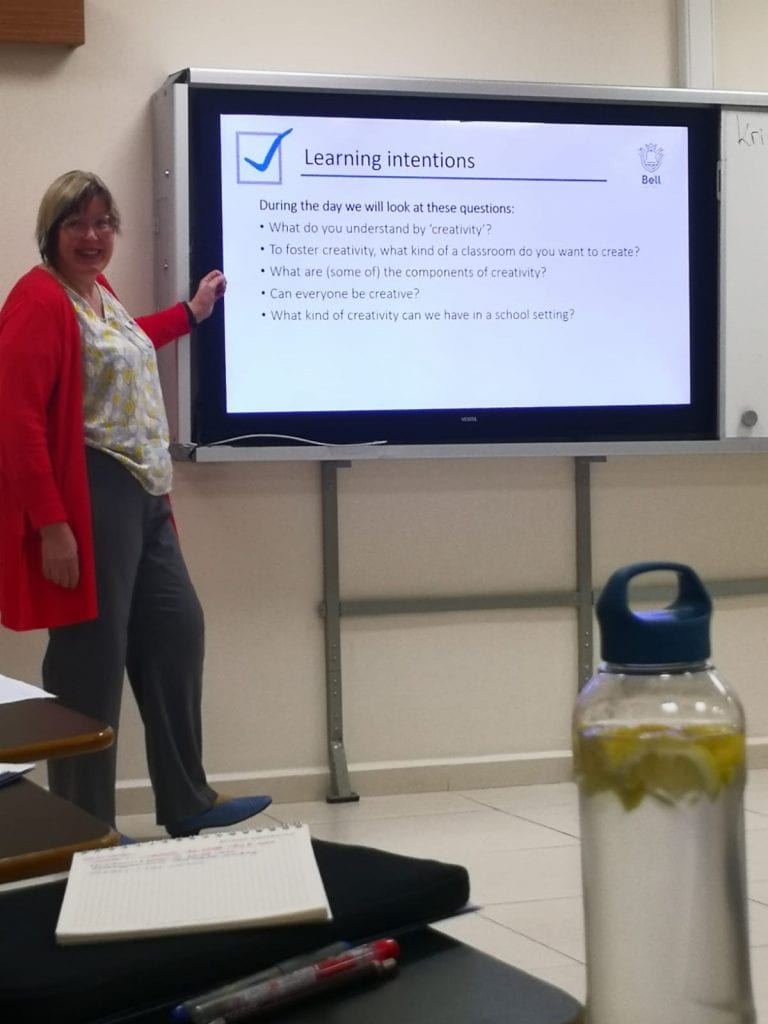
The most striking question for me was if everyone could be creative ( she said YES!) because, we all know that sometimes we are tired or constrained by the time and syllabus we need to follow. In a nutshell, I was asking myself if I was creative enough or not, and if not, what I can do to hone my creativity. I particularly liked this definition of creativity Kristina shared:
Creativity: a cluster of skills that are needed to produce ideas that are both original and valuable (Sternberg, 2001)
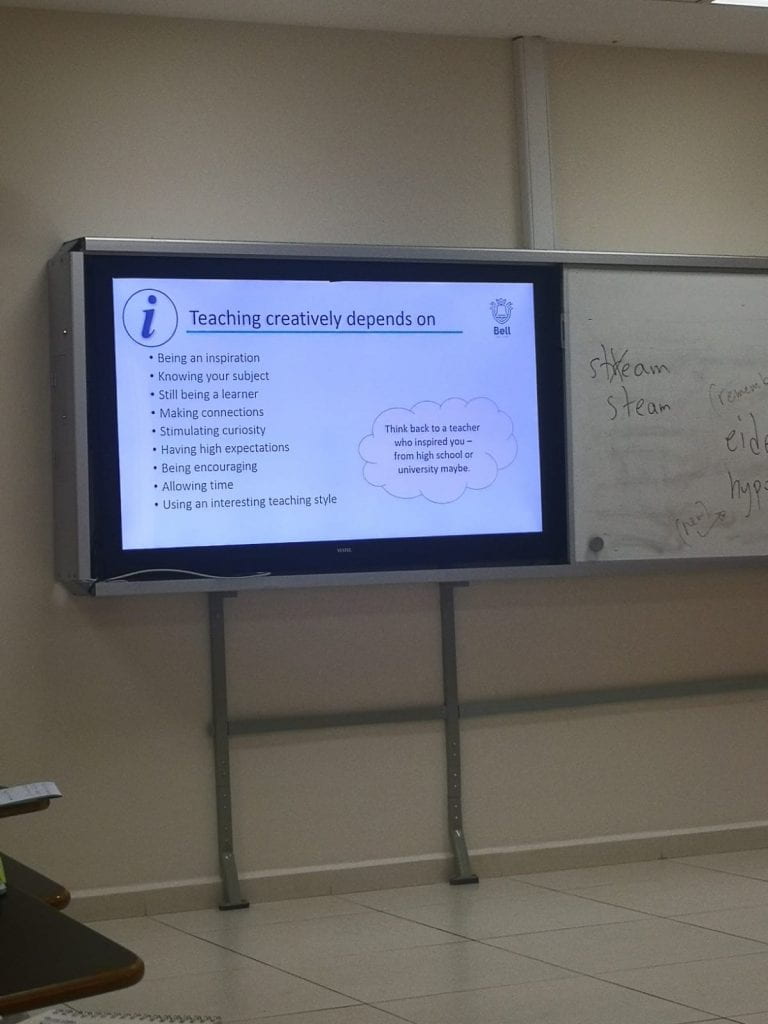
According to Kristina, “creative teaching needs to be grounded in an understanding of where the learners really are. What is their reality? What do they want and need? Who am I to brush their concerns away and say that my agenda is better? How about negotiating between them and the externally imposed curriculum/exam structure?”. Creativity involves action and purpose, even if the purpose changes as the idea develops. Definitely lots of food for thought.
We have to remind ourselves that creativity should come with a target audience and value, otherwise it would be just a meaningless approach to teaching. Likewise, the value lies in relation to task.Kristina also shared 2 creative activities that can be used as an ice-breaker on the first day of class.
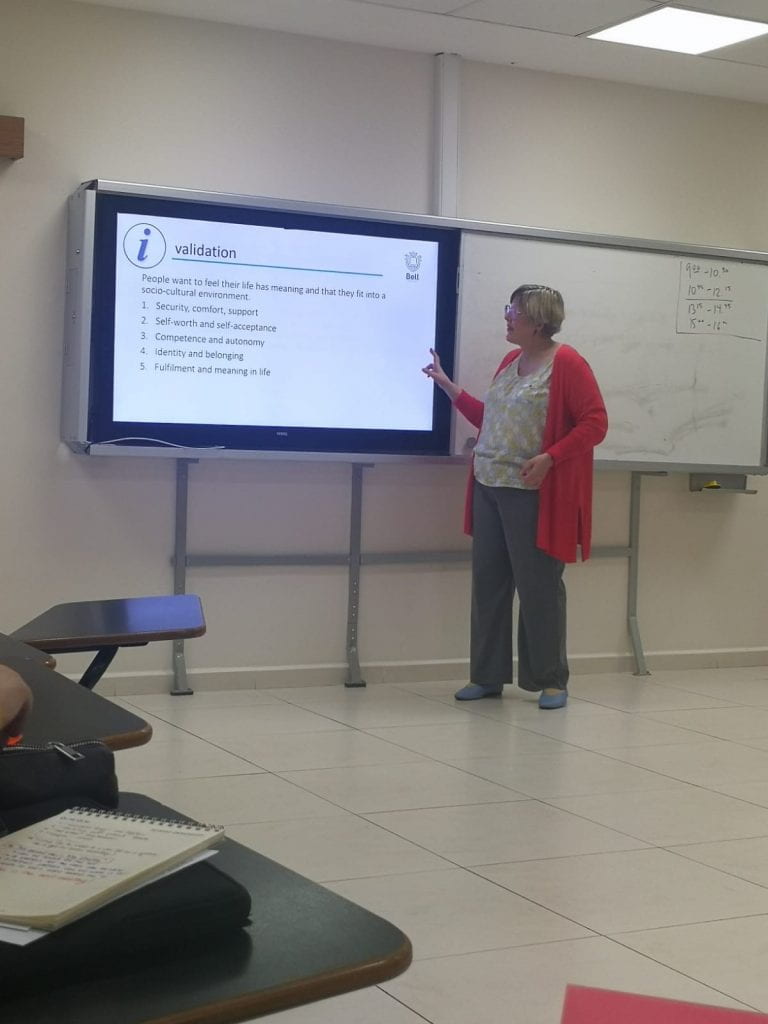
On the first day, Kristina shared some fun icebreakers.I will call the first activity “ All about your name” where she shared a questionnaire about names and gave a copy for each student ( teacher). Then, each student should choose 4 or 5 questions they would like to answer about their name. Next, the teacher should divide the class into 2 groups, in a row, where one student would face another and move to the next one ( left or right) after 2 minutes ( similar to “ Speed Dating”). The main idea is to make students choose and talk about the questions they want to answer about their names – questions that interest them, motivate them to talk and make them feel safe, afterall, learning a language can be threatening sometimes. Therefore, I believe it is crucial to help our students to feel connected and understood.
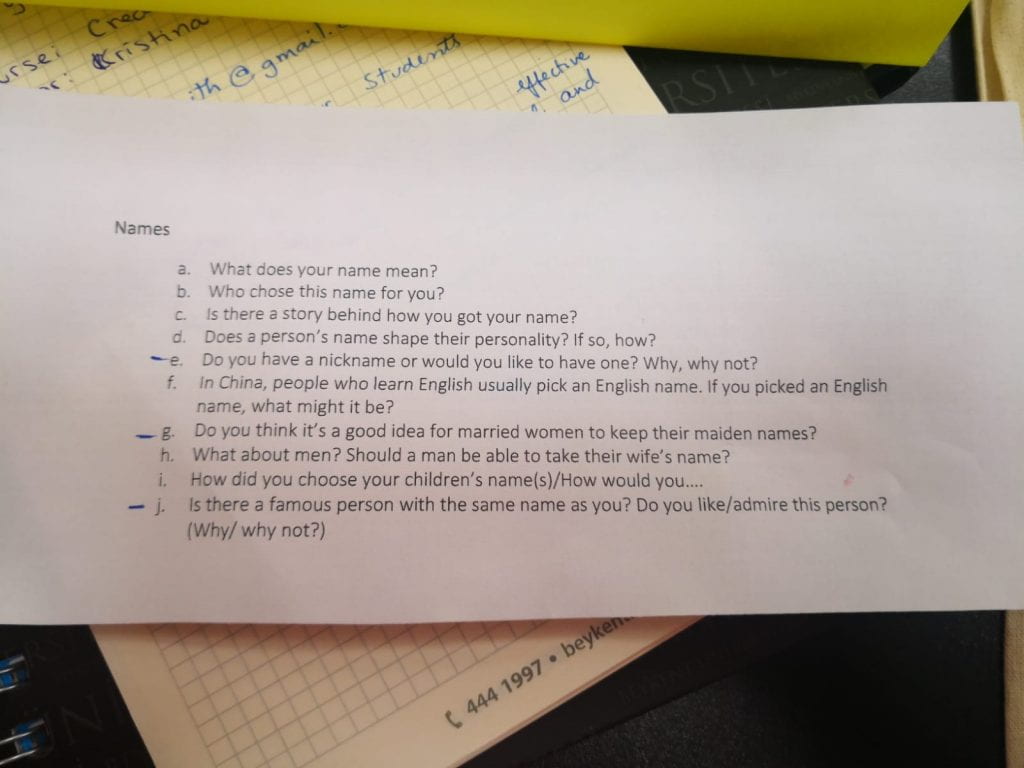
The other task is a Dictation “ Is this you?”. Teacher dictates some disputable sentences such as “ Kadikoy is the best place to live” or “ I am a morning person”. Then, students should choose the most suitable column to fit the sentence: This is definitely me / This is not me / This is me, occasionally. I enjoyed this activity because we can personalise the sentences to what we believe our students might like/ think/ dislike.
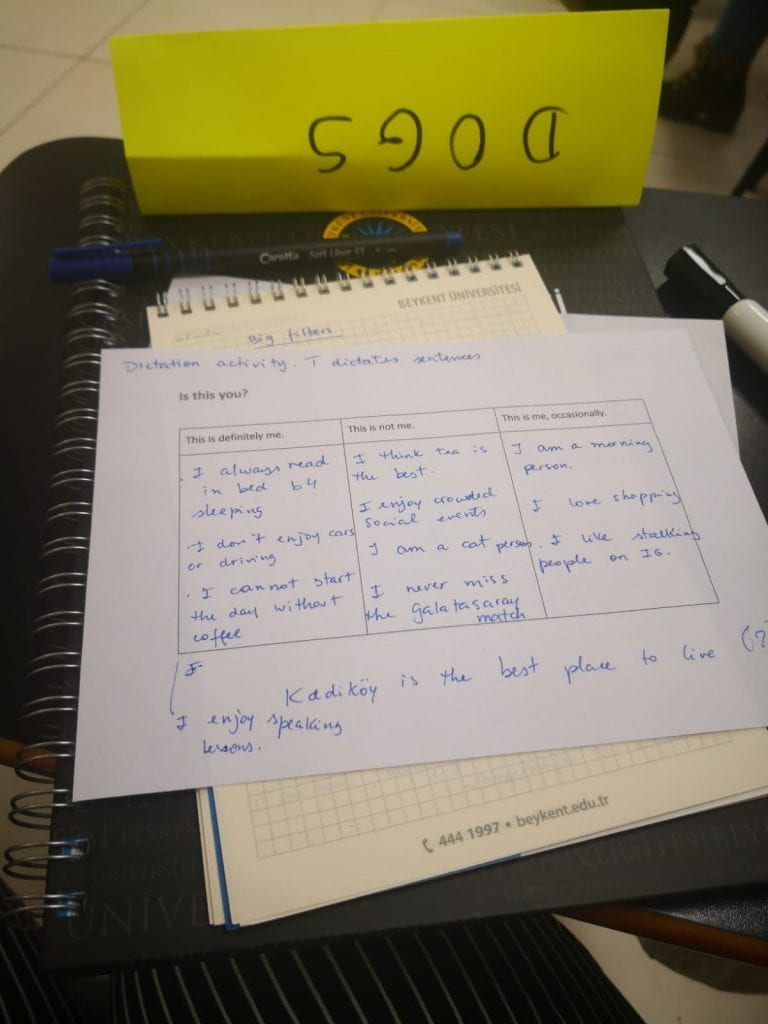
I have also found pair work dictations rather fun and creative, especially because it adds the element of surprise and it is quite student-centred. Kristina shared this task:
Topic: Pairwork dictation
1. Take turns.
2. The person with paper A starts. Read one sentence. Your partner has paper B and needs to write the missing word(s).
3. Next, listen to your partner read one sentence. Write the missing word(s).
4. Continue to read, taking turns.
5. When you finish, check the paragraph together.
6. Write your answer in the box on Paper B and show the teacher.
Paper A
The Car
A guy is at home making coffee and realises that he doesn’t have any milk, so he grabs his keys from the table, unlocks his car and drives to the local shop. He buys the milk and _________ the shop and then __________ that his keys are still in the locked car. The car doors are all locked and the windows are all done up. After thinking a while, he _____ __________home to make his coffee. How did he get into his car to drive home? (He ________ __________ the lock or windows and didn’t have a spare key).
Paper B
The Car
A guy is at home making coffee and _________ that he doesn’t have any milk, so he grabs his keys from the table, __________ his car and drives to the local shop. He buys the milk and leaves the shop and then notices that his keys are still in the locked car. The car doors are _____ _________ and the windows are all _________ _____. After thinking a while, he is driving home to make his coffee. How did he _______ ________ his car to drive home? (He didn’t break the lock or windows and didn’t have a spare key).
Your answer:
Follow up questions:
1. Which words might you pre-teach, if any?
2. What follow-up questions would you ask after this activity finishes?
Topic: Pairwork dictation
1. Take turns.
2. The person with paper A starts. Read one sentence. Your partner has paper B and needs to write the missing word(s).
3. Next, listen to your partner read one sentence. Write the missing word(s).
4. Continue to read, taking turns.
5. When you finish, check the paragraph together.
6. Write your answer in the box on Paper B and show the teacher.
Paper A
The Lift
Every day, Beth Anderson leaves her London flat on the 24th floor and takes the lift down to the ground floor, where she takes a taxi to her job at the bakery. She _______ _________ all day selling London’s and sausage rolls. After work, she goes home, gets in the lift and goes up. However, she always gets out ____ ______ ________ floor and walks up _____ ______ ________ flights of stairs home. If it’s raining, she doesn’t walk, but goes all the way to the 24th floor using the lift. Why?
Paper B
The Lift
Every day, Beth Anderson leaves her London flat on the 24th floor and _______ _____ _______ down to the ground floor, where she _______ ______ _______ to her job at the bakery. She works there all day selling London’s finest cakes and sausage rolls. After work, she______ ______ , gets in the lift and ________ ___. However, she always gets out at the 20th floor and walks up the final four flights of stairs home. If it’s raining, she doesn’t walk, but goes _____ _____ ________ to the 24th floor________ _____ _______. Why?
Your answer:
Follow up questions:
3. Which words might you pre-teach, if any?
4. What follow-up questions would you ask after this activity finishes?
Both these stories come from: https://www.tefllemon.com/using-logic-puzzles-as-a-tefl-speaking-activity-for-adults and were edited lightly.
Finally, another highlight of the course for me was revamping the way to allow the students to ask questions, especially those which require critical thinking skills.They are:
● Synthesizing points of view
● Testing assumptions
● Inferring information
● Comparing and contrasting
● Generalizing
● Analyzing
● Supporting opinions
● Hypothesizing Outcomes
We can pick a simple question, for example,shopping for bread or a new mobile phone. After giving a model to students, they can come up with critical thinking questions such as: a) Do you think whole bread is healthier than white bread? ( comparing)b) Is it true that you don’t like eating bread in the evening? If so, why is that? ( testing assumptions) c) How often would you eat bread if it was calorie-free? ( analysing/ hypothesizing outcomes). It is important to remember that students need some scaffolding to make these questions and follow up answers when they interview people.
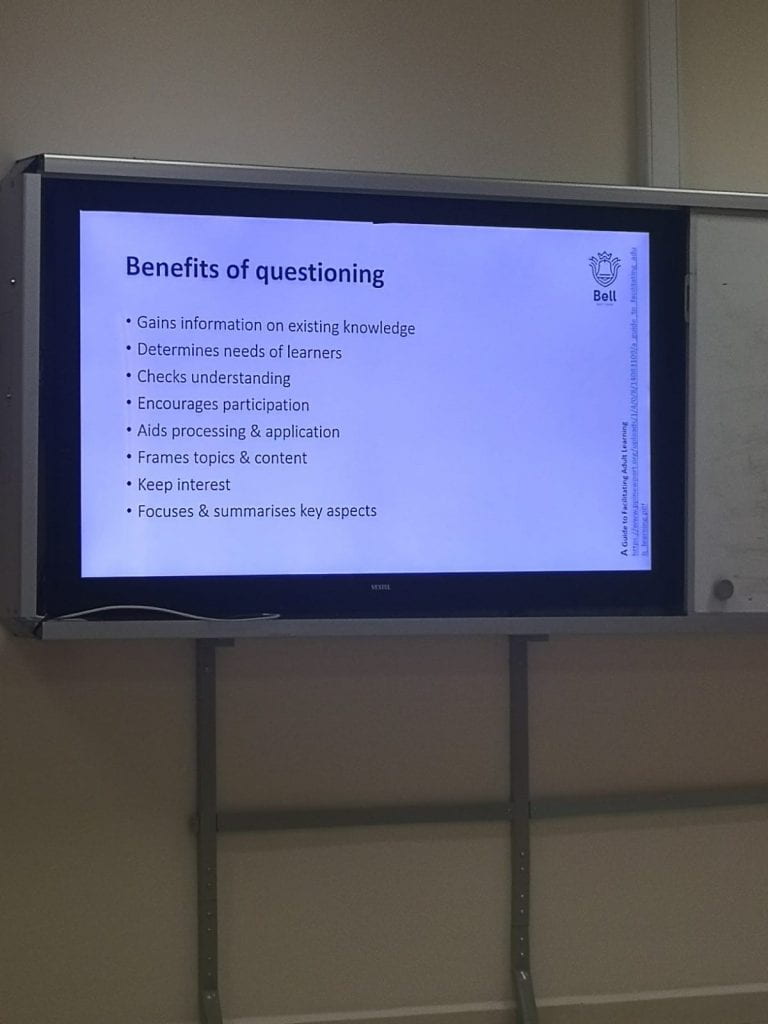
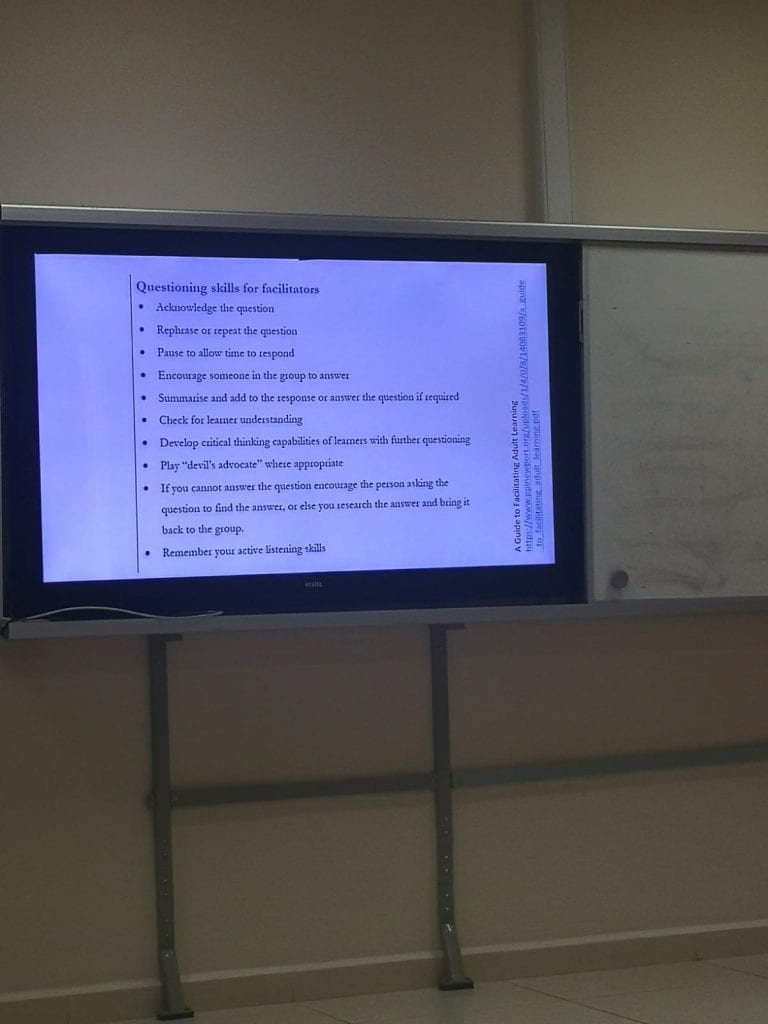
As a teacher, I hope I can always enhance my students’ feelings of competence, autonomy and relatedness. By doing that, I intent to promote not only a creative learning environment but also a meaningful and memorable one as well. Thanks, ScoLA for letting me attend this magnificent developmental course.

Leave a Reply